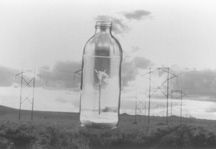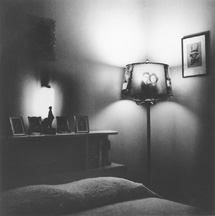Of Latino Lenses
MACLA's new show gathers together the work of Chicano and Chicana photographers
By Ann Elliott Sherman
KICKING OFF the parade of photographic exhibits coming our way, Chicanolandia at MACLA's San José Center for Latino Arts bills itself as a pioneering show by virtue of being the first national exhibit of photography by Chicanas and Chicanos. For all that, it's an intimately scaled affair, featuring 47 photographs by nine artists.
Guest-curated by Chicano photographer Robert Buitrón in collaboration with Movimiento Artistico Del Rio Salado (MARS) Artspace of Phoenix, Ariz., the show has a decided Aztlán emphasis. Nearly all the participants are residents of the border states; the sole exception, David Guerrero of Roanoke, Va., focused his lens on Southwestern arches and arroyos. But as Louis Carlos Bernal points out in his eponymous essay, Chicanolandia "goes beyond fixed political or geographical boundaries." The work of one photographer may occasionally share cultural references with that of another artist, but the show is refreshingly free of any sense of knee-jerk, party-line responses.
Curiously, though, it has been installed here with all the male artists near the door, and all the female photographers at the far end of the space. This placement accentuates the nagging sensation that, good as it may be, the guys' stuff feels more familiar and expected, while the women are doing more unconventional, surprising things.
Part of that effect may be due to the fact that we've seen some of Bernal's work in other shows. His chromogenic development prints make terrific use of unusual lighting, whether it's the neon behind the bar in Albert and Lynn Morales, Silver City, New Mexico, 1978 or the hazy auras of the bedstead light and floor lamp in Recamara de mis padres. You don't just look at but enter these intimate scenes, adjusting your vision to the dictates of their environs, just as you would walking into a dark cantina at midday.
Bernal's gelatin silver prints straddle the line between photodocumentary and art for art's sake, often with a welcome infusion of ironic contrast (El Gato Bar) or unexpected point of view (Milagros, Untitled) that tweaks the norm. But, like the chromogenic development shots, they inhabit the realm of "witness to the world."
In Miguel Gandert's Reflexiones de mi Corazon, the artist's homages to his roots take the form of photo-offset lithographs arranged like aged pages from a family album. Gandert has a knack for unifying disparate shots with repeated images or before-and-afters, so that his elegiac series is like a canción with a familiar refrain. Even Don Antón's surreal visual sandwiches--gelatin silver prints that layer images densely fraught with symbolism--are readily tagged by the mind as photographs.
Contrast these two approaches to the medium with Christina Fernandez's inversion of the usual photographic equation of light = flesh. Here, the body is a dark mystery bound by light, illumined only at the edges, combusting with a volcanic sexual energy, the points of sensory input electrically charged. The idea of printing the negative image may not be novel, but setting the dark ablaze the way Fernandez does alchemizes what the eye sees into what the sixth sense knows.
KATHY VARGAS also translates the lens' literal veracity into a vision not limited to this world's rules. Delicately subtle hand coloring, a hazy layering of fabrics and ghosted images echoing the iconic still lifes of flora and fauna give the natural world an ethereal interpretation.
Vargas' work functions like offerings to the spirits, bridges between the seen and unseen. Black illusion netting, frayed cloth, barbed wire--the things of this world put up between us entrap the open wings of the rainbow bird (Priest's #1-3/Netted), hold hostage the illumined death (From Series Oracion/Head).
The hyperrealism of cibachrome's vivid colors is employed to great effect in Delilah Montoya's revelations of the truth hidden in obvious titles borrowed from Catholic liturgy. In her photographs, containers memorializing the stories behind the present reality float against landscape backdrops: a jar of unattached doll's arms reaching from the ashes for a syringe tells the tale of a graffitied crack house in Station #7, Jesus Falls a Third Time; a glass bell preserving a couple's prom photo hovers over their side-by-side graves in Until Death Do Us Part. Montoya "puts up" the evanescent past and present to demonstrate the changing face of what's accepted as a given just as women once canned preserves of a season's harvest for the next winter.
[ Metro | Metroactive Central | Archives ]
This page was designed and created by the Boulevards team.

Station #10, Jesus Is Stripped: Delilah Montoya uses the hyperrealism of cibachrome colors to great effect in her photographs on view at MACLA's "Chicanolandia" show.
Room Service: Hazy, surreal source lighting gives an aura of mystery to Louis Carlos Bernal's photographs.
Chicanolandia runs through Aug. 31 at MACLA/San José Center for Latino Arts, 510 S. First St., San Jose. (408/998-2783)
From the August 15-21, 1996 issue of Metro
Copyright © 1996 Metro Publishing, Inc.
